The Birth of Taiko
As percussion instruments are generally the most primitive instrument in any society, the taiko existed and was used in the ancient Japan over 2000 years ago. According to some archeological and anthropological researches, ancient people in the Jyomon era already used drums as a communication tool or an instrument for religious rituals. However, the percussion they used is guessed to be quite different from the one used today.
By the fact that taiko we use today resembles those in China and Korea, the ancienttaiko was probably introduced to Japan from the Asian Continent as far as India. The continental music came to Japan around 5th - 6th century along with the waves of Chinese and Korean cultural influence based on Buddhism. When the Taiho Ritsuryo, the oldest constitution of Japan, was enacted in 702, a department of the imperial court music was established in the Imperial Palace. The department has been inherited directly till now, honored as the Important Intangible Cultural Asset. Various kinds of taikos such as San-no-tsuzumi, Furi-tsuzumi, Dadaiko, Tsuri-daiko, Ninai-daiko, Kakko, Kaiko, and ikko are used in the court music. The style is said to be one of the roots of taiko music we know today.
After the samurai class gained power since the Kamakura era started in 1192, a new cultural movement of ethnic Japanese started to appear. Many original art forms were born under the feudal Japan, unleashed from the Chinese and Korean cultural influence. For example, a Noh play was created in the Muromachi era (1336-1573). A famous Kabuki play emerged and quickly became popular in the Edo era (1603-1867) as well as Nagauta. Taiko had an important role in those art forms as an accompaniment, and were gradually diversified to various sizes and shapes. Moreover, the development of other instruments such as Shamisen, Koto and Shakuhachi also influenced the shaping of those art forms now categories as traditional. The methods of taiko playing have been inherited through generations under the iemoto system (the system of the teaching of a traditional Japanese art by a master), although western music has become predominant in modern Japan.
Meanwhile, taikos have always been used in religious ceremonies or local festivals as well. It is very common to find taikos at Shinto shrines and Buddhist temples. This shows that taiko has associated with a religion very closely. The ancient people might feel the power of deity in the rumbling sound of taiko and taiko had a role as a sanctifying instrument. Usually, men who were authorized by the priest played taiko at special occasions. Otherwise at the religious ceremonies, common people have enjoyed dancing along with taiko at local festivals. Such local festivals still remain and it is fun to watch their unique taiko performances.
Modern Taiko History
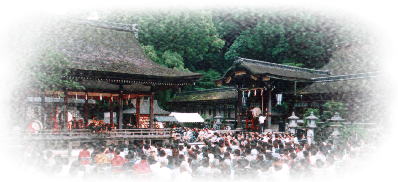
"Kumi-daiko" literally means a taiko ensemble that consists of various taikos. Surprisingly, the Kumi-daiko style was invented in 1950's by single person although taiko itself has a long history. Daihachi Oguchi, the founder of Osuwa Daiko, created the Kumi-Daiko style in 1951. He was actually a jazz drummer. One day, he was asked to interpret an old sheet of taiko music for the Osuwa Shrine, which was found in an old warehouse. The sheet music was written in an old Japanese notation and he couldn't understand it at first. He, fortunately, found an old man who had performed the tune, and then he succeeded in interpreting it at last. However, as a jazz player, the rhythm pattern of the tune was too simple for him to play. He wondered why nobody played taiko together. A marvelous idea came across his mind and made him decide to break through the tradition. Inspired by a western drum set, he formed a group in which each player beats a different taiko; in short, he gave the group a function as a drum set. A high-pitched Shime-daiko established a basic rhythm like a snare drum does. A growling Nagado -daiko added accents like a bass drum. His intention was right to the point, and this epoch-making invention changed the taiko music forever.
Following the Osuwa Daiko, Yushima Tenjin Sukeroku Daiko, which was based on Edo-bayashi style, was formed in 1959 by the four members: Yoshihira Ishikawa, Yutaka Ishikawa, Seido Kobayashi, and Motoei Onozato. The characteristics of the group were the speed, powerful playing and unique choreography. Later, the group was split to two groups, the Yushima Tenjin Sukeroku Daiko and Oedo Sukeroku Daiko founded by Seido Kobayashi.
Another historic group was born in 1969: it was Za Ondekoza. Tagayasu Den founded the group on Sado Island located in the northern part of the Japan Sea. The group was totally different from the other groups ever formed. The members were not natives of the island, actually they came from all over Japan, and some of them were youths disaffected with bustling big city life. They lived together in a commune, cultivated fields, and ran a marathon daily. The rigorous physical training seemed to be the group's dogma to create a good sound. In 1975, the sensational event that they performed taiko on stage just after they run the whole Boston Marathon astonished the entire world. Za Ondekoza was credited with the first Japanese group with spreading the taiko music all over the world. In 1981, the group was split to Kodo, which consists of the original members of Za Ondekoza, and new Za Ondekoza, which was formed by Den. Now Kodo is the most famous taiko group and is busy traveling around the globe.
Taiko in Municipal Activities
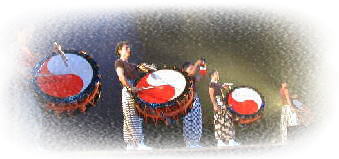
The period from 1970's to 1990's in Japan seemed to be the Renaissanceof taiko music. The activities of Osuwa Daiko and other early kumi-daikogroups in 1960's, and the taiko performance at the Tokyo Olympic in 1964ignited the phenomenal taiko boom for next decades. People started to payattention to their local cultural heritages, which were almost vanishingaway. Many municipal organizations took action on preserving them and,consequently, a lot of hozonkai (municipal preserving organization) wereborn here and there in Japan. Adding to that, the government promoted thoseactivities with a vast sum of subsidies in 1980's. The end result is thatapproximately 4,000 taiko groups have been formed in Japan since then.An important renovation in education was also enacted recently. The musiceducation in Japan had focused on the western classical music and disregardedtraditional Japanese music in modern times. The educational renovationin 2002 required schools to use Japanese traditional instruments includingtaiko as teaching materials. It is sure that the new generation will reactivatetaiko music in the 21st century.
Taiko in the United States
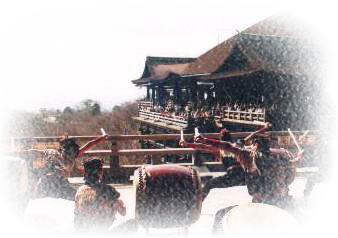
Taiko was brought to the United States by Japanese immigrants there in the early of the 20th century. The main usage of taiko in those days was to play in temples or in festivals as Miya-daiko (temple drum or sacred drum). The Japanese immigrants preserved their culture in the New World, probably, to maintain their identity and cooperative spirit as Japanese. For example, Bon-Odori, a dance in Bon festival reposing the ancestor's souls in summer, is one of the cultural activities they loved to keep. According to resources, taiko drumming of Bon-Odori was already established in Hawaii as early as 1910. The Kanazawa Kenjinkai, an organization of Japanese immigrants from Kanazawa Prefecture in Japan, also brought it to San Francisco in 1930's.
When the World War II broke out and Japan declared war against the United States, a tragedy stroke those Japanese immigrants. They were taken into internment camps as enemy aliens. After the war ended, the Japanese-American tried hard to assimilate into American culture, in order to remove the prejudice. The succeeding generation lost much of their Japanese culture and even the language. Taiko drumming was also forgotten for a long time till 1960's.
In the storm of the Civil Rights Movement, some Japanese-American wanted to revive their identity as Japanese, and they found a way to express it in taiko drumming. At the end of 1960's, two pioneer groups opened the door for taiko music in North America: the San Francisco Taiko Dojo and the Kinnara Taiko. Seiichi Tanaka, born in Tokyo, immigrated to San Francisco in 1967 and founded the San Francisco Taiko Dojo in the following year. He was a student of Daihachi Oguchi, the legendary founder of Osuwa Daiko. His style of taiko drumming was a synthesis of Osuwa Daiko, Oedo Sukeroku, and Gojinjyo-daiko. The San Francisco Taiko Dojo was the first taiko group introduced the Kumi-daiko style to the United States. The group inspired many following taiko groups and greatly devoted to spread taiko throughout North America for decades. The Reverend Masao Kodani of Senshin Buddhist Temple founded the Kinnara Taiko in 1969.
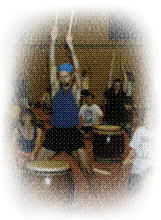
Differed from the San Francisco Taiko Dojo, the Kinnara Daiko based on a Buddhist organization and basically performed for events of the temple. The group is one of the unique Japanese-American Buddhist taiko groups still going on. Following them, San Jose Taiko was founded in 1973. The group was also based on a Buddhist organization. One of the Buddhist priest of the organization was a friend of the Reverend Kodani of the Kinnara Daiko and was inspired by him to establish a taiko group in San Jose. Most of the members were Sansei at first. They are urged to revive the culture of their grandparents; meanwhile, they tried to express their identity as Japanese-American in taiko drumming. They made it become a symbolic art form of Japanese-American culture.
Taiko in the 21st Century
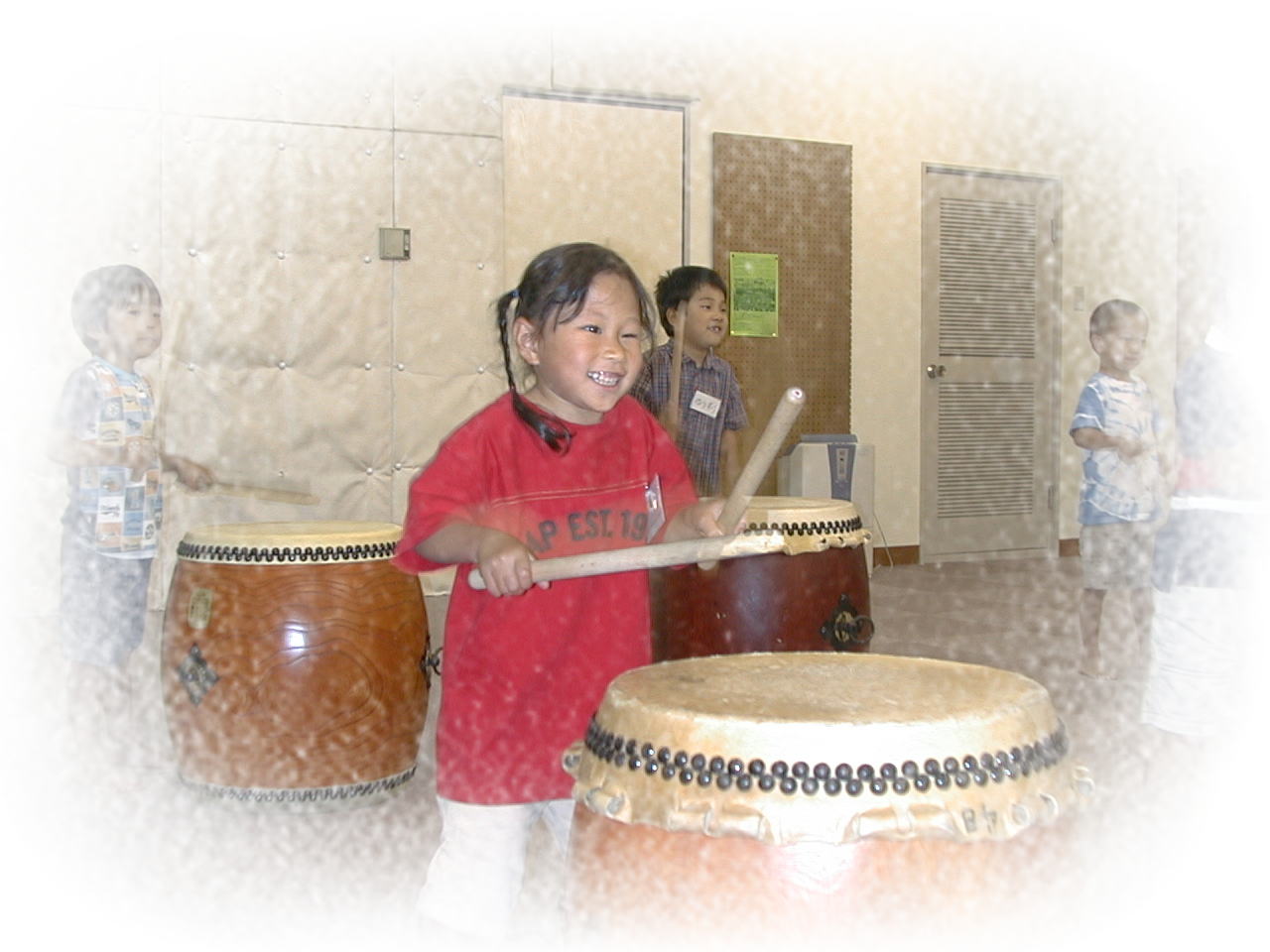
Inspired by the successful world touring of Za Ondekoza and Kodo, a vast numbers of taiko groups have been established in Japan as well as around the world, especially in North America during the few decades. It is estimated that there are approximately 1,000 taiko groups in the United States and Canada. The taiko boom has been spreading through out Europe, Australia, and South America as well. That is a worldwide phenomenon and will continue in the 21st century. Why did it happen? There seems to be many reasons. Some people got attracted to the beautiful Japanese art form respecting Japanese culture. Some were amazed by the dynamic sound of taiko, which is incomparable with any other percussion in the world. Some might start to play it as an exercise to maintain their health. But there is one sure common reason why taiko is so attractive simplicity. You just strike it with sticks, and a sound comes out. Without distinction of sex, age, or nationality, everyone enjoys the simple and earnest response from taiko. Amazingly there are some taiko groups, which include deaf peoples. They can play in concert successfully, feeling vibrations made from other players. That is a magical power of taiko.
Taiko is the heartbeat of Japan, which has vitalized our souls throughout the long deep history. Now it is also becoming a universal musical language making peoples in the world get closer. The instrument has an unlimited potential, as the fact that the kumi-daiko style was invented and developed in relatively short period shows. traditional but new that is taiko. Taiko music continues to evolve with the commencement of 21st century; and maybe it will be you, who create a new generation of taiko music.

